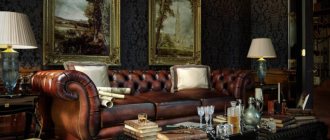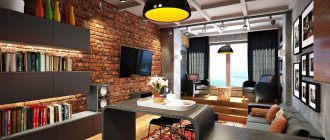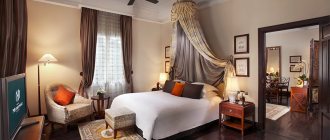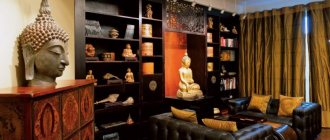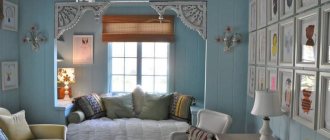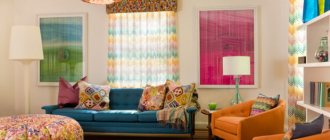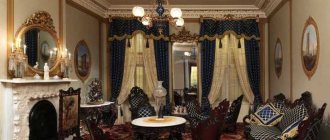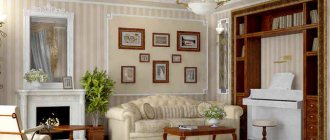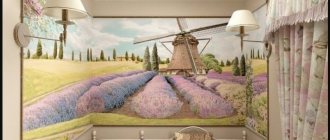Features of the Arabic style
- Arabic design stands out from others due to its religious component. The Holy Quran prohibits the presence of sculptures and picturesque images of people and animals in the design of a home. Therefore, when decorating premises, mosaic graphics, patterns of geometric lines and shapes, exquisite and complex ornaments are used, and floral themes are successfully used.
- The panels on the walls are made in square, diamond or hexagonal shapes, even the carpets and floor tiles are decorated with combinations of geometric shapes. The room must have a clearly marked and decorated center.
- The most popular architectural forms of the Arabic style are the sphere and the semicircle, combined into complex structures, resulting in exquisite arches and majestic window openings.
- By tradition, the oriental style does not imply the presence of familiar doors. The space is delimited by curtains, arches and semi-arches, colonnades. Arabic design implies a certain privacy, so it does not have the trendy European open floor plans.
How to decorate a kitchen
An Arabic-style kitchen is a trendy solution for an apartment or house. Here tiles are used not only for flooring, but also for laying on walls. You can decorate an Arabic kitchen only in a room that is sufficiently spacious and bright.
Arabic style cuisine is characterized by:
- Space zoning . The work area is made of natural wood or stone, the dining area is furnished with upholstered furniture, decorated with pillows.
- The kitchen uses less textiles in the form of curtains, carpets and bedspreads, but it is present in the form of lambrequins and laces that decorate the furniture.
- The color scheme is exclusively pastel tones. This applies to all interior elements.
- The work area is represented by a work surface and open shelves that are hung on the walls. The lower compartments should be closed with doors or curtains.
Related article: Interior in Italian style: simplicity and bohemianism (+36 photos)
The main feature in the design is the use of handmade items and dishes of authentic origin. The tiles should be painted with colorful patterns on both the floor and the walls, since they are the main decoration of this room.
Secrets of oriental style and ideas for kitchen decoration (2 videos)
Interior in Arabic style (36 photos)
History of origin
The Arab way of life is based on religion, which permeates all areas of Eastern life. Therefore, she did not ignore the rules for designing and decorating living spaces. The first thing that distinguishes the life of the East is the secrecy of the internal structure of the family. This is precisely related to the fact that for a long time the principles of the Arabic interior style were unknown to the broad masses of the world's population. And only in the middle of the 19th century Europe discovered the wealth of oriental decoration.
- Unlike the constant alternation in interior design styles that are fashionable at different periods of time in the European part of the world, the Arabic style is very conservative and dictated by loyalty to tradition, and therefore has not changed for many centuries. This is not only its design, but also its historical value.
- The second distinctive feature of oriental interiors is that not a single animate creature is reflected in any of the ornaments, lush patterns, or ornate elements. This rule is prescribed by the Muslim scripture. That is why the variety of oriental paintings is so rich in cyclical ornaments and patterns.
Following the traditions of the nomadic way of life still dictates peculiar rules in the decoration and design of the oriental interior: this is the wealth of textiles, the decoration of rooms in the form of tents with the help of canopies and many pillows and carpets, which were once spread right on the sands of the deserts during times of long wars or wars. trade trips.
The Arabian-style room is decorated with oriental patterns, carpets, colorful pillows and many accessories.
Textile decoration
Unlike furniture, there are a lot of textiles in the Arabic style. Striped and patterned pillows scattered throughout. There are bright colorful bedspreads on the sofas, ottomans and armchairs.
It is impossible to imagine this interior without soft oriental carpets. Yellow, red, golden - they are on the floor, armchairs and sofas, hanging on the walls or lying in a stack.
Window openings are often half covered with light tulle and thick silk, velvet, or organza curtains. The curtains have an oriental pattern and many folds. The tiebacks are made of twisted silk cord, at the ends of the brush. The upper part of the windows is decorated with a lambrequin. Thick curtains also hang on the doorways.
More: Carefree marine style in room decoration
History of style
Nowadays, this trend is very popular all over the world, but few people know that until the 7th century no one had even heard of it. Its formation was actively promoted by the rulers of those times, who wanted to see around them beautiful, rich decorations that corresponded to their religion. So let’s say they avoided using figurines or images of living creatures in decoration, since the scripture says that they should be “avoided.” That is why local creative individuals invented characteristic Arabic prints, which were used to decorate palaces everywhere. As for its popularity in Europe, it dates back to around the 19th century, when people began to show serious interest in the Arab lifestyle.
Decorative items in Arabic style
Handmade products are a special atmospheric decoration in the Arabic interior. This gives a special charm and uniqueness to each interior. The most striking element is almost always the carpets. And as we already know, they are present in great abundance in the Arab interior. They are made from natural wool. Eastern masters have achieved great success in this craft. In Russia, such products can cost millions of rubles. And all over the world they are rated very highly.
We understand that not everyone will be able to purchase such unique carpets, therefore, to create the atmosphere, a synthetic carpet with an oriental intricate pattern will be enough.
In addition to carpets, there are other products that are very popular in the East.
- Carved wooden products. For example, boxes.
- Forged twisted elements
- Inlaid interior details
- Embroidery in national style
- Mosaic surface
- Hand painted trays
For the mosaic surface, wood of different species and shades and pieces of different sizes are used. Often precious stones or mother of pearl are woven into this ornament, which look very impressive.
Inlay is used on furniture and all horizontal and vertical surfaces. They take gold, silver, bronze, and ivory for it. The voids left between the stones are filled with blue or blue paint.
Decoration Materials
▫ The ceiling is decorated with paintings, multi-stage structures or decorative panels. Coffered ceilings, multi-level with lighting or suspended mosaic coverings are successfully used.
▫ The walls are painted or wallpapered. When painting, one color is used or intricate oriental script is applied to wet plaster. The wallpaper should have a geometric or floral pattern or fabric imitation. ▫ Floors are usually finished with tiles or mosaics. The tile size is usually small, 10x10 cm, or less. ▫ Wood is used to decorate window and door openings. Timber frames, shutters and grilles add a special accent to the room. To live in a house decorated in a truly Arabian style, you need to have a special worldview. The East is bliss, a calm rhythm of life, comfort, the slow passage of time, which is hardly possible in the modern world. Therefore, the Arabic style in the interior requires a respectful and careful attitude, the introduction of certain philosophical and religious traditions and rituals into life.
Luxurious Arabic finish
In the Arabic style, smooth surfaces are not used; textures made of wood, forging, textured plaster and natural stone are more often chosen. The bathroom uses tiles or mosaics arranged in amazing patterns. Steps and even furniture are laid out with mosaics.
The walls are decorated with expensive moire, silk, velvet or brocade. Some people choose wooden lace panels, plain staining, or wallpaper with geometric or floral patterns. Intricate oriental script is applied to wet plaster.
Along the perimeter of the ceiling are arabesques, ornaments and paintings, sometimes textile drapery. The ceiling design is multi-stage, made of decorative panels or suspended mosaic coverings. It is not uncommon for a room to be decorated with coffered or illuminated multi-level ceilings.
10 by 10 cm tiles are placed on the floor, creating ornaments, mosaics, or laid out of stone. If desired, lined with natural wool carpet.
More: Ideas for decorating a rustic interior
Door and window openings are wooden.
Textiles - special attention
Oriental style without carpets – no, it’s something else. This textile product should be given due attention. They are all around: on the walls, sofas, on the floor.
If the curtains are on the windows, then they must be heavy, with a lot of draperies and folds, with tassels along the bottom edge. Both curtains are intercepted in the middle with cords and secured on both sides of the window. The top is decorated with a lambrequin or bandeau.
Principles of Arabic style
The Arabic style in the interior is based on the traditions of Islam. For example, in the Holy Quran, images of living beings are strictly prohibited. This is reflected in Arabic design. There is simply no sculpture or painting here. But this small drawback is compensated by the ability of oriental artists to depict complex patterns. The decor is a geometric pattern
, entwined with vegetation. Moreover, each element of the painting is drawn to the smallest detail. Patterns are usually used to cover walls, ceilings, carpets, columns, and pillows. There should be no empty monochromatic spaces here.
Another trend of Islam is panels decorated with arabesques from the Koran. The texts are intertwined with beautiful patterns, making the interior truly aesthetic and inspiring.
- Arabs have led a nomadic lifestyle throughout history. In the interior this is expressed by a luxurious tent, carpets and pillows.
- The curtains of the peoples of the East are traditionally bright, decorated with memorable patterns.
- The beamed ceiling and lamps combined with narrow windows create a magnificent atmosphere that you want to plunge into.
- Handicrafts and famous Arabic mosaics
Another feature of the Arabic interior is expensive handicrafts. The cost of elite silk carpets reaches several tens of thousands of dollars! Eastern masters know their craft and bring to life unsurpassed masterpieces from which it is simply impossible to take your eyes off. In a real Arabian room, literally everything is covered with carpets: the floor, walls and ottomans.
The famous Arabic mosaic is no less popular. It decorates walls, furniture and columns. The base of the mosaic is dark blue, and the ornament itself is covered with mother-of-pearl.
History of the Arabic style in the interior
The Arabic style was formed over many centuries and for many years was carefully protected from the eyes of Christians. Only a few European travelers had the opportunity to see with their own eyes the luxury of the interior decoration of the palaces of the sultans and viziers. Until the beginning of the 18th century, the Arabic style in the interior was widespread only in the countries of the Middle East and North Africa.
But with the beginning of active penetration of Europeans into these territories, the situation began to change. Upon returning to their homeland, many successful colonialists brought with them items of Arabic decor and tried to recreate a luxurious oriental interior at home.
Gradually, the Arabic style gained popularity in Europe, especially among the wealthy bourgeoisie in big cities. The fashionable oriental design direction could not compete on equal terms with traditional European interior styles, but it always had its adherents.
In the second half of the 20th century, many conservative Arab countries began to pursue more open policies towards foreigners. Large-scale development of the vast reserves of Middle Eastern oil has caused a rapid improvement in the living standards of local residents.
Mass construction of comfortable oriental-style hotels has begun in the United Arab Emirates, Saudi Arabia, Kuwait and other countries in the region. The Arabic interior style has become not just a popular design trend, but also an obvious standard of luxury. And among its adherents we can safely include many VIPs, show business stars and major politicians of world importance.
On the online platform Very Important Lot, visitors can take part in art auctions and purchase antiques. Here you can directly buy paintings for room decoration from talented contemporary authors.
General characteristics of the Arabic style
The Arabic style does not provide for empty surfaces - everything should be decorated with a pattern. According to the laws of Islam, you cannot place canvases or paint walls in your home that depict animals, people or plants. The painting is an outlandish pattern consisting of phrases from the Koran, and decorated with additional ornaments.
A distinctive feature of Arabic patterns is clear lines with a description of the smallest details. The background of such arabesques should be a rich color: crimson, black, red, emerald.
The Arabic interior style contains a huge number of textile elements:
- All kinds of decorative pillows. They should be of different sizes and different shapes. They are made of silk and chintz, the surface of the material is painted with golden embroidery.
- Carpets with thick painted patterns are used as floor coverings. One room can have several carpets of different colors. Sometimes they have fringe or tassels.
- Tile is the main floor covering in any room.
- Carpets are also used to decorate walls. In concept, they are the same as their floor-standing counterparts.
- Light curtains made of transparent and translucent material that zone the room into space for relaxation, work and other activities.
- The windows are decorated with thick curtains with oriental motifs, which are additionally equipped with lambrequins and laces.
- The color palette is contrasting, but at the same time bright. Any decorative element combines several rich shades to create an intricate pattern.
Related article: Swedish style interior: pastel colors by Karl Larson
This is the main motif of the Arabic decoration of the room. In addition, small upholstered furniture is used. The entire space of the room should be filled as much as possible with decorative elements and furniture.
On video: how to decorate an interior in oriental style
Lighting
The Arabic style interior is characterized by rich lighting: large wrought iron chandeliers, various lamps, wall and table lamps, sconces, candelabra. All light sources have a complex design and emit a mysterious golden glow, which adds richness to the color of draperies and interior fabrics. Dim, diffused light provides an intimate and relaxing interior atmosphere. Aroma lamps with oriental spices fill the air in the room with sweet aromas.
Characteristic features for kitchen design
- Zoning of space. The work area is made of wood or stone, the dining area is furnished with upholstered furniture.
- Textiles are present in the form of curtains with laces and lambrequins.
- The color used is pastel.
The main feature of design in the Arabic style is the use of things that are made by hand.
The tiles are painted with patterns, both those that are used to decorate the floor surface and those that are used to frame the walls.
There are a lot of photos of Arabic style in a modern interior on the Internet, and therefore you can see how beautiful and stylish the style is and get certain design ideas for yourself.
High-Tech style in the interior - impeccable and stylish design in 95 photosJapanese style in the interior - 180 photo ideas on how to create a stylish design
- Gothic style in the interior: correct design of non-standard design (150 photos)
Photo of interior in Arabic style
If you cannot imagine your home without the noisy range of Arabic decor, but cannot definitely make a choice in favor of a specific design, the Arabian fairy tale captured in the photo in a modern version is designed to help you.
Bedroom
It is the bedroom that is the embodiment of Arabic grace and a blissful atmosphere of complete relaxation.
A bedroom in an Arabic home is a concentration of grace, comfort and splendor
Living room
The living room space in the Arabic style is designed to demonstrate luxury and wealth, and even somewhat demonstratively. An abundance of gilded accessories, expensive handicrafts, a variety of large-scale space design - all these are necessary components of an Arabic home.
Living room in Arabic design invites you to spend time slowly and mentally
Kitchen
The comfort of a family hearth begins in the kitchen. The Arabic style in the kitchen emphasizes the richness of kitchen utensils, their value and exclusivity.
An Arabic-style kitchen combines the bright colors of ceramic mosaics, the comfort of luxurious textiles, and the elegance of oriental utensils.
Bathroom
Famous patterns and mosaics of Arab countries are extremely popular in bathroom decoration. It is in this style that golden or bronze colored plumbing fixtures, massive taps, towel holders, curtain rods and other plumbing accessories are appropriate.
An Arabic-style bathroom can be a real work of oriental art. And this is reflected in the luxurious interior details.
Textiles in the interior
Decorative pillows on furniture are not just of different shapes, but also of different sizes and colors. All pillows are made of chintz or silk. There is a beautiful gold thread patch on the entire surface of the fabric.
- The flooring is carpets, the designs on which are hand-painted. In one room in the Arabic style, several carpets of different colors are used. Sometimes carpets have tassels and fringes.
- It is customary to lay tiles on the floor in this style.
- The walls are decorated with carpets.
- The curtains are light, made of translucent material. Curtains are used to divide the space into zones.
- The windows are decorated with high-density curtains with oriental motifs, which are equipped with laces.
- The color palette is contrasting. Each decorative element contains a combination of rich shades, as well as the creation of a pattern.
These are the most basic motives for decorating a room in the Arabic style. Moreover, furniture in the Arabic style is compact and not large in size.
The space is filled to the maximum with furniture and decor.
Arabic style furniture
In the Arabic interior there is not much furniture familiar to the “European”. Instead of chairs, for example, pillows are used. Armchairs, sofas, and ottomans must be covered with colorful satin bedspreads.
Interior items are made of hard wood and decorated with carvings and inlays. Among them are necessarily present: - A low sofa with a spacious sleeping area; — Ottoman; — Low cabinets with small capacity; — Many bedside tables of various shapes, often decorated with carvings.
Interior decoration of rooms in Arabic style
The Arabic style is the obligatory observance and veneration of age-old traditions in the process of making furniture and decorative items, an abundance of handmade products and a subtle oriental play with materials and textures.
The splendor of Arabic style furniture
Despite the fact that the oriental interior is luxury and wealth, the amount of furniture in it is strictly limited. The central place in the Arabic-style living room is occupied by a low sofa upholstered in velor, velvet, brocade or satin.
Interior of a modern living room in Arabic style
In addition to it, purchase a small ottoman or several ottomans. The design of the living room should be very comfortable. Often, upholstered furniture is decorated with hand-made bedspreads with oriental patterns.
Stylized living room in Arabic style
If the size of the room allows, then in the living room you can select an area for tea drinking, which is decorated with the help of a small tea table. In this case, the role of chairs is successfully performed by pillows.
Elegant seating areas in Arabic style
If a studio apartment is decorated in the Arabic style, then most often the kitchen is combined with a dining area, in which a large dining table made of natural wood is placed. It is decorated with carvings and inlays. The chairs are upholstered in thick fabrics with a pronounced texture or oriental patterns.
Kitchen in brown shades in Arabic style
The focal point in an Arabic-style bedroom interior must be the bed. She is given a central place in the room. The bed is decorated with many decorative pillows and a beautiful bedspread. An oriental interior cannot do without a canopy.
Elegant beds in Arabic style
Translucent tulle or moire gives the bed a mysterious look, as if it were the bed of a Persian queen. The headboard also receives special attention. It is made of wood, decorated with ornaments, and draped with velor or brocade. A niche decorated in an oriental style can also serve as a headboard.
Luxurious interiors in Arabic style
Most often, the chest of drawers is replaced with a large carved chest. Wardrobes are not used in traditional Arabic interiors. Small items and decor are stored on shelves or in bedside tables. The role of a dressing room is performed by specially equipped niches, which are decorated with wooden doors with openwork carvings.
Carved decorative elements in Arabic style
All furniture in the Arabic style is made only from natural materials. According to tradition, it is customary to decorate it with enamel, gilding, and inlay.
Interior decoration using traditional Arabic items
Modern Arabic style in the interior
Authentic Arabic style in the interior of small apartments rarely looks good. However, if you really want to have such a design for your living room, bedroom, bathroom or kitchen, choose an eclectic option.
You can create a minimalist monochrome design in your home and give it an Arabic touch. For this purpose, it is enough to use a couple of original authentic parts.
This could be an original lamp, a carpet with bright arabesques, a vase or a hookah. A “canopy”, which is curtains draped in an original way on the wall, is also perfect.
And don't forget about the screens. This piece of furniture will become a real assistant when zoning a studio apartment.
An original technique and arrangement of an artificial arch with pilasters on one of the walls, for example, on the one where the television panel is hung.
Distinctive features of the Arabic style
- The religion of eastern countries largely influences the formation of aesthetics in the interior. It is necessary to respect and observe Arabic traditions in the setting of your home.
- Handmade decorations. There are many craftsmen in the East who do amazing things. They are especially highly valued in Arabic interiors.
- Imitation of luxurious and rich furnishings. Not everyone has the opportunity to decorate a truly palace interior. Therefore, they resort to imitation.
- Brightness and richness of shades, abundance of gilding in details and surfaces.
- Textiles and all surfaces in the house with oriental ornaments. These are climbing plants, geometric shapes, and small patterns that connect large intricate shapes.
- A ban on paintings and statues that depict animals or people. This is against religion.
- Using arabesque - a medieval oriental pattern. Callouts from the Koran are also sometimes added, framed accordingly.
- Carpets, bright fabrics, heavy curtains. It all has to be expensive or look like it.
- Decorating the sleeping area with a canopy. Traditional and recognizable oriental technique. It recalls the history of Arab nomads.
- The presence of arched hands. Openings in the shape of an elongated rounded cone, extending into the ceiling, are an integral attribute of the oriental interior.
- Abundance of living plants. Dwarf trees - citruses or avocados are very much appreciated in the Arabic style and add a special charm.
Photo of Arabic style in the interior
Interior decoration in Arabic style
So, you have already decided that oriental luxury
, bright colors, colorful decor and ornate Arabic ornaments - this is exactly what you want to see in your home. So, it's time to move on to action.
- Floor
The most consistent style is a floor made of stone or a colorful mosaic of tiles; in the sultry countries of the East, it was precisely such a floor covering that could give residents much-desired drops of coolness on hot days. In our area, such a colorful floor needs to be insulated, otherwise it will feel cold in winter. You can make everything much simpler - maintain the style and leave the floor as it is. And to do this, you just need to cover it with carpets, maybe one large one, or maybe several small ones.
- Walls
Fabrics of darkish shades with oriental patterns
, arabesques made with golden colors are an ideal option for wall decoration. Wallpaper with appropriate patterns is also perfect for this purpose. Images of ornate lines of Arabic script will help create a special atmosphere. Traditional Persian carpets elegantly emphasize the style. Recently, more and more often, the Arabic style in the interior has accepted the decoration of walls with wooden panels, effectively decorated with the finest openwork carvings and dense paintings of oriental ornaments.
- Ceiling
Painted beams will look great in a room with high ceilings
. You can also wallpaper with small patterns of geometric shapes. The interior will be given originality by a fabric-covered ceiling with a fastening in its very center; beautifully hanging waves of bright fabric on the ceiling create the effect of a tent.
Accessories
What needs to be added to the design of the room to recreate the Arabian image in it? • Lamps. They are located on the walls, on tables, and descend from the ceiling. Manufacturing material – colored glass, openwork metal.
• Dishes. Ceramics, metal - sets for water and wine, hookahs, and vessels for washing hands are made from these materials. They are usually decorated with inlay and painting. • You can advantageously emphasize the sophistication of the room by using vases, vessels, copper trays, hookahs, musical instruments, chess, richly bound books, wood and wrought iron products.
Oriental decor
The Arabic style interior contains many decorative elements:
- Textile decor.
- Mosaic with geometric lines, figures, complex patterns.
- Indoor plants growing in the East.
- Items from coinage and books in decorated bindings.
- Openwork bird cages and forged mirrors.
- Crystal, metal and openwork lamps, which are decorated with tassels, beads, stones and carvings.
- Sets of ceramic or metal utensils for water and wine, jugs and bowls for washing your hands.
- The Arabic style of the room is emphasized by vases and vessels, copper trays, hookahs, musical instruments, and chess.
You cannot decorate with new objects - photographs, portraits, figurines and paintings with images of living things.
Furniture and accessories in Arabic style
If you have already decorated the interior of your home in the spirit of the East, immediately remove standard tables, bulky cabinets, traditional chairs and armchairs - they have no place here. Do you need furniture
in Arabic style. But large soft sofas and extraordinary ottomans with matching fabric upholstery will fit perfectly into the interior. Tables can be of different sizes, the main thing is that they should be low and be a work of art with rich inlay and beautiful carved legs. At such tables they simply sit on cushions, which are generously placed throughout the room. If we talk about accessories, then their choice is simply endless; the most popular among them are hookahs, jugs, vases and candlesticks.
An Arabian-style house is an excellent solution for cheerful and self-confident
people who want to turn their everyday life into a fabulous kaleidoscope of colors, textures and deep traditions of the East. If you are interested in other interior design trends, you can always take advantage of the endless tips from WESTWING. We already have answers to your questions!
